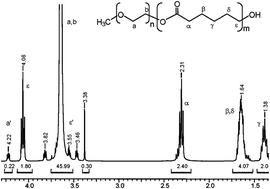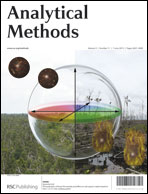Recently, there was much attraction in amphiphilic block copolymers composed of methoxy poly(ethylene glycol) (MePEG) and biodegradable polyesters such as poly(caprolactone) (PCL). This copolymer significantly has applications in drug delivery systems. According to literature reports, efficiency of drug delivery and particle cellular uptake could be affected by many characteristics, such as particle size, different compositions of the particles, surface properties, different cell lines and cell densities, temperature. Hu et al. showed that the particle size is the key factor to determine the cellular uptake efficiency and it is found that the composition and molar mass of the copolymers are influential on the particle size. The present paper firstly discusses response surface methodology (RSM) as an efficient system for building a mathematical model and optimization of the apparent molar mass (Mn) by size-exclusion chromatography (SEC) (Y1) and nuclear magnetic resonance (1H NMR) (Y2). In this work, RSM is used to optimize the physical and chemical variables such as time, temperature, MePEG/CL and amount of Sn(Oct)2. A 24 small factorial central composite design (CCD) was employed. After evaluation of experimental results, a 2F1 model was found to be fit for Y1 response (SEC) and quadratic model for Y2 (NMR) without any requirement of power transformation. The selection of model was done on basis of high adjusted R2 value and lowered p-value for each model in individual analysis of each response. Through desirability analysis, it was found that SEC has a good precision/repeatability but a generally poor accuracy/reproducibility in determination of Mn. NMR is not suitable for determination of Mn for high molar mass PEG–PCL copolymers. Thus, the information that can be derived from NMR spectra is restricted because of broad and overlapping signals, poor solubility of polymers or non-availability of suitable solvents. NMR coupled with partial least squares (PLS) regression is applied to determine the Mn of MePEC in the present study. A PLS regression model with a coefficient of determination (R2) of 0.8444 and root-mean-square error of cross validation (RMSECV) of 0.5625 was obtained in the spectral range δ 0.28–7.28 ppm. The results obtained in this study indicate that 1H NMR spectroscopy can be used as an easy, rapid and novel tool to quantitatively predict the Mn of MePEC.

You have access to this article
 Please wait while we load your content...
Something went wrong. Try again?
Please wait while we load your content...
Something went wrong. Try again?


 Please wait while we load your content...
Please wait while we load your content...